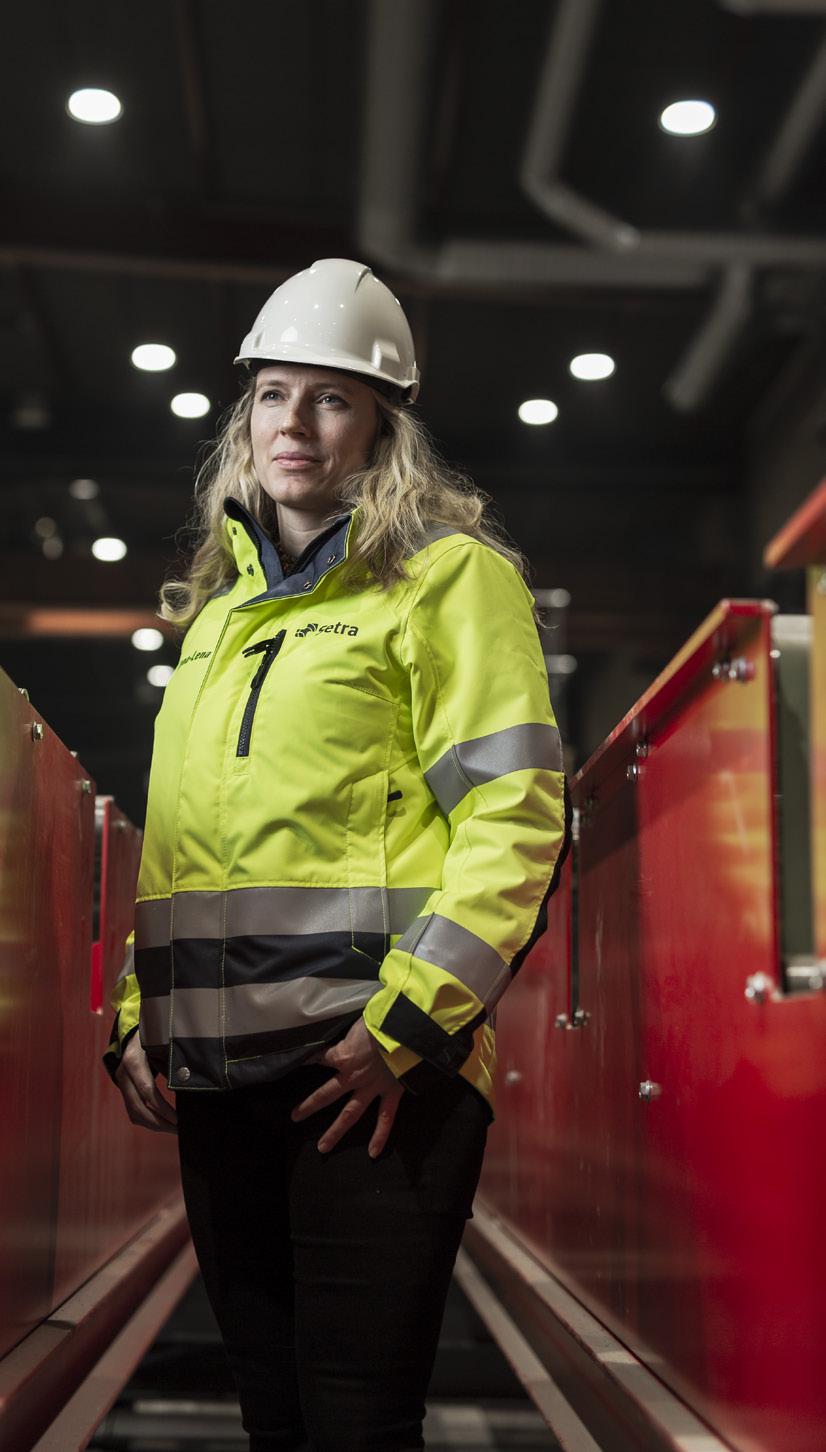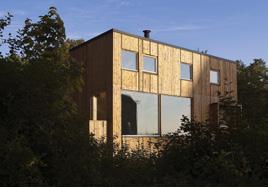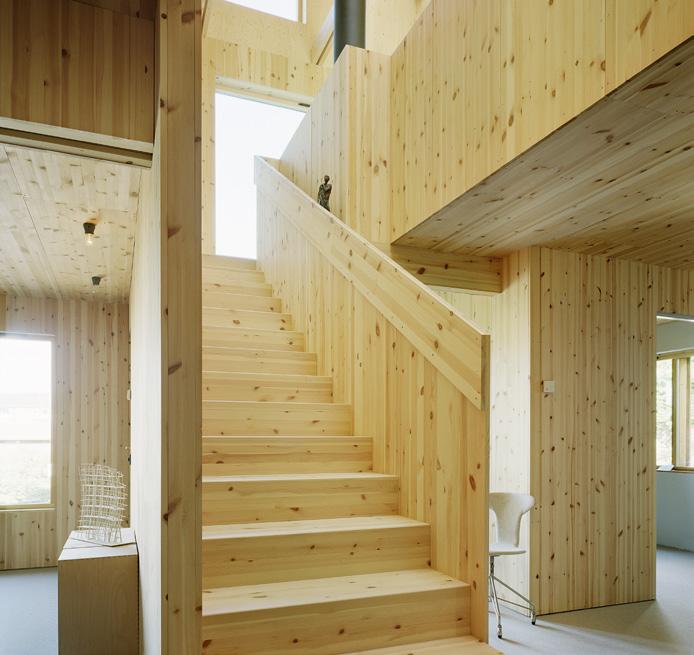
10 minute read
Our portfolio
The factory for future buildings Climate-smart raw material Sustainable transport
This year saw the development of Setra’s wood industry hub for processed products. Our latest investment in cross-laminated timber is a win for everyone, not least our customers, who are now even better placed to achieve their climate goals and build more sustainably.
Our portfolio Culture and colleagues Resource-efficient business
THE PEOPLE and the machines are all now in place, ready to get Setra’s investment project in Långshyttan rolling on schedule. The new factory for cross-laminated timber, or crosslam, is an ultramodern plant with machinery that enables us to manufacture the market’s largest crosslam elements. Prefabricating the solid, large-scale elements in the factory ensures easier assembly on site and keeps construction times down. The crosslam elements are made of wood primarily sourced from our own sawmill in Heby, while the raw material is harvested in the forests of central Sweden.
“We’re seeing wood construction capture market share, as more and more builders try using crosslam and realise the benefits. They understand the forces at work and are choosing to develop their skills and promote themselves in the field of wood construction,” says Anna-Lena Gull, who has been responsible for establishing the new factory.
Glulam offers commercial synergies Production in the crosslam factory is digitalised and uses the latest Computer Numerical Control (CNC) technology, which makes it possible to produce elements to order for each specific project. The technology also makes production of the panels highly efficient, with minimal waste. The proximity to Setra’s glulam factory, also located in Långshyttan, is a huge advantage. Glulam is used in most crosslam projects, so this brings several commercial synergies for the customer in terms of both production and transport. “In addition to the employees’ expertise in finger-jointing and laminate bonding, our glulam manufacturing has come a long way in terms of efficiency, short lead times and quick deliveries, and this successful methodology is now being implemented in the crosslam factory,” continues Anna-Lena Gull. Cross-laminated timber really took off in the late 1990s, with Austria leading the way in both production and use. When, in 1994, Sweden lifted the ban on building high-rise blocks in wood, interest in the material grew, although it is only in recent years that crosslam has taken on a more prominent role in Swedish construction.
“One of Setra’s advantages is that we own the whole chain from sawmill to end product. This allows us to calibrate every part of our business and make improvements to ensure optimal use of the raw material,” says Anna-Lena Gull.
Part of the solution to climate change Of all the benefits that crosslam offers, the environmental and climate arguments are among the most important. Wood is a renewable raw material and the manufacture of the structural elements takes place in an energy-efficient process with a low carbon footprint. The material also serves as a carbon sink for the whole lifetime of the building. It used to be assumed that the greatest climate gains could be achieved during a building’s operational phase. Now we know that the construction and material phases account for a considerable portion of the climate impact during the lifecycle of a building.
“Wood is part of the solution to the world’s climate issues and will play a key role in the transition to a fossil-free society. If we are to meet our climate commitments, we simply have to switch to building much more in wood,” says Anna-Lena Gull.
Setra’s investments have got everyone in Långshyttan excited about the future. In addition to new jobs, the conditions are in place for the establishment of new businesses in related fields.
“It feels right that Setra’s development of new, sustainable construction systems is going hand-in-hand with the positive development of Långshyttan,” says Anna-Lena Gull.
Cross-laminated timber Cross-laminated timber (crosslam) is an engineered panel comprising planed timber that is glued together in layers at 90 degrees to each other. The material is dimensionally strong and has a high load-bearing capacity in relation to its own weight. Using large and stable crosslam elements ensures both rational and efficient assembly on site and keeps construction times down. A building in crosslam differs from buildings in concrete and steel, since the engineered wood binds large quantities of carbon for the whole lifetime of the building. This makes cross-laminated timber a climate-smart choice.
Anna-Lena Gull, VP Building Solutions
Strong focus on planed products
2020 will mark the start of production at Setra’s next big investment – a new trimming and planing line in Hasselfors. This investment opens up new opportunities for us to meet the global demand for planed products.
What does the investment mean? Improved efficiency and a stronger position for Setra in the global construction market. The planed products will account for around two thirds of the estimated production volume of 320,000 cubic metres. This will provide greater flexibility and better service for new and existing customers alike.
What will the product portfolio look like? We will primarily be producing planed construction timber in various dimensions, including roof truss timber and joists. The timber will be sorted mechanically and strength-graded according to the standards that apply in the respective markets. Having the planing integrated into the production process cuts out a whole stage and enables the end product to be created under one roof. This brings many benefits, not least the savings on transport.
What parts of the world will the products be used in? We will continue our strong presence in Scandinavia and the rest of Europe. The difference now is that we can explore more markets and make the most of the economic situation in different parts of the world.
How do you see Setra Hasselfors developing further? I hope and believe that the positive attitude towards building in wood will continue, in which case we can expect considerable expansion in the markets for our broad and flexible portfolio of planed products.
Jouko Mäkimattila, Product Manager, Planed Wood Products
Our portfolio
Our wood products are manufactured from renewable raw materials and contribute towards the transition to a sustainable society.
Our opportunities and challenges Here at Setra, we believe in Grönsamhet. This means that we want to do business where everyone prospers – not just ourselves but also our customers, society and nature. By processing wood from responsibly managed forests into sustainable products for the construction and wood industries, we are helping with the transition to a fossil-free society, in partnership with our customers.
Increasing construction in wood is a core issue for Setra, since wood is renewable and binds carbon dioxide for the whole of its lifecycle. Our challenge is to deliver products and services that make it easy to choose wood over other materials such as steel and concrete.

Our business concept The future is built on wood. With a raw material that originates from responsibly managed forests, we create refined climate-smart products and solutions for construction, housing, pulp and paper manufacture and energy production. We thereby help our customers do better business in a global marketplace and are part of the solution in the transition to a bioeconomy.
How we work
A broad range Setra’s product range spans from sawn wood products and construction timber to further processed products such as glulam, door and window components and structural elements. Our range also includes bioproducts such as bark, sawdust and wood chips.
As a result of the construction sector and wood industry’s growing demand for value-added products, Setra is focusing on increasing the degree of processing and developing customer-specific solutions. In 2020, we will begin delivering building solutions in cross-laminated timber and in 2021 we will ramp up production of planed construction timber.
Where Setra’s products go (percentage of sales)
16% BIOPRODUCTS
73% SAWN WOOD PRODUCTS remain visible, including flooring, furniture and doors, plus pressure-treated products such as decking. Spruce is the dominant wood for building and construction, since it meets high strength requirements. It is also used in glulam and cladding.
Processed wood products Our portfolio of processed products includes glulam, decking, joists, construction timber and components for doors and windows. The customers are builders’ merchants and wood product manufacturers, primarily in Scandinavia. Glulam is also sold in project-specific solutions directly to the builder or via a builders’ merchant. 2020 saw the launch of standard halls in glulam for industrial, warehousing and agricultural use.
Setra’s glulam factory in Långshyttan has worked long and hard on perfecting its production and is now able to deliver glulam to the customer’s specifications within six working days of ordering.
11% PROCESSED WOOD PRODUCTS
Sawn wood products Sawn wood products in spruce and pine are important for our export markets and account for the majority of Setra’s sales. Planks and boards from our sawmills can be found in everything from furniture and packaging to finished buildings around the globe. The largest markets are Europe, North Africa, the Middle East and Asia. Our customers operate mainly in the wood processing industry comprising, for example, planing mills and manufacturers of glulam, buildings and packaging.
Pine is easy to process and is often used for products where the wood will

Bioproducts Making use of the whole log and using it as efficiently as possible is a key issue for Setra. Around 50% of each sawlog is turned into boards and planks, and the rest becomes bioproducts such as bark, chips and sawdust. These bioproducts are sold on as cellulose chips, biofuel or animal bedding. The customers are largely paper and pulp mills, and energy producers.
100,000 m 3

The amount of crosslam that will be produced annually in Långshyttan. This would be enough to build around 4,500 apartments.
Where Setra’s bioproducts go
(volume m 3 )
43% HEATING AND POWER PLANTS
9% PELLETINDUSTRY
1% OTHER
47% PULP AND PAPER MILLS
1,727 GWh In 2019, Setra delivered 1,727 GWh bioenergy. That is enough to heat around 200,000 apartments.
The transition to a bioeconomy, where we use renewable resources from the forest, for example, instead of fossil fuels and materials, suggests a growing market for bioproducts. Setra’s investment in extracting bio-oil from sawdust is one example of many new applications for these bioproducts. Read more about the investment on page 34.
Crosslam and planed products Demand for wood as a construction material is rising, and there is every indication that the trend is only in its infancy. The construction industry accounts for substantial greenhouse gas emissions and rapid change is needed to achieve the world’s climate goals. Wood is the only renewable construction material and it generates a significantly lower carbon footprint than steel and concrete, as confirmed by comparative lifecycle analyses. Setra’s new wood industry hub with crosslam manufacture in Långshyttan and trim saw with integrated planing machine in Hasselfors are designed with these developments in mind. Modern industrial wood construction using cross-laminated timber makes it possible to create large-scale projects in a more efficient and competitive manner than ever before. We apply a project model where we maintain a close dialogue with the customer and provide expertise in
What our customers think Helping our customers to do better business is part of Setra’s business concept and our vision for Grönsamhet.
We work hard to maintain a high level of service and expertise, and in order to find out what customers think, we conduct regular customer surveys in all our markets. The latest survey, which went out to European customers in 2018, shows that customers are very satisfied and consider our delivery reliability to be much higher than that of our competitors.
The customers praise the ease of making contact with us and obtaining service and state that we are efficient and provide the support required. Setra’s net promoter score in the survey is +67. This is a measure of how inclined the customers are to recommend us, on a scale that ranges between -100 and +100. The most recent survey of Swedish customers, conducted in 2017, also produced a net promoter score of +67.
project planning and structural engineering, so that even those building in wood for the first time can move forward with confidence. The flexibility in the factory enables us to optimise the production of structural elements and minimise waste. Future customers for Setra’s building solutions will be contractors, construction companies and building pre-fabricators, primarily in Sweden and Scandinavia. Planed construction timber from Hasselfors is expected to benefit customers in the construction industry in Scandinavia, Europe, the USA and Australia.







